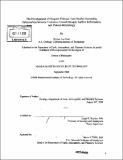| dc.contributor.advisor | Leigh H. Royden. | en_US |
| dc.contributor.author | Cook, Kristen Lee | en_US |
| dc.contributor.other | Massachusetts Institute of Technology. Dept. of Earth, Atmospheric, and Planetary Sciences. | en_US |
| dc.date.accessioned | 2009-06-30T16:15:01Z | |
| dc.date.available | 2009-06-30T16:15:01Z | |
| dc.date.copyright | 2008 | en_US |
| dc.date.issued | 2008 | en_US |
| dc.identifier.uri | http://hdl.handle.net/1721.1/45769 | |
| dc.description | Thesis (Ph. D.)--Massachusetts Institute of Technology, Dept. of Earth, Atmospheric, and Planetary Sciences, 2008. | en_US |
| dc.description | Includes bibliographical references. | en_US |
| dc.description.abstract | This thesis addresses processes associated with the uplift, deformation, and erosion of orogenic plateaus. The timing and mechanisms of uplift of the Tibetan Plateau and the Altiplano are the subject of ongoing debate. Central issues include the strength of the lower crust and the role of lower crustal flow, the relative importance of continuous deformation versus block deformation, and the possibility of lithospheric delamination. The goal of this thesis is to further explore several of these issues using a combination of numerical modeling, field observations, and thermochronology. I investigate controls on the large-scale evolution of the Tibetan Plateau and the Altiplano using a new quasithree-dimensional viscous flow model that allows for both the development of a weak lower crust and lateral and temporal viscosity variations. Modeling motivated by the Tibetan Plateau shows that lateral variations in crustal strength can have a significant effect on surface velocities throughout the plateau, as well as on the location, shape, and slope of plateau margins and the overall plateau morphology. Model results suggest that crustal strength heterogeneities may be responsible for a number of seemingly unrelated aspects of Tibetan Plateau morphology and deformation. Modeling motivated by the Altiplano explores the relationship between subduction angle, the strength of the lower crust, crustal thickening, and surface shortening in the Central Andes. Model results illustrate that lower crustal flow above regions of steep-slab subduction can redistribute material along strike and can explain discrepancies between surface shortening and crustal thickness in the northern and southern Altiplano. I address the distribution of Middle Cenozoic deformation on the eastern margin of the Tibetan Plateau by using field observations and thermochronology to document an episode of extension and constrain its timing to the Oligocene. Finally, I examine the response of a major river system to flow over an abrupt plateau margin by using topographic data, cosmogenic nuclide dating, and numerical modeling to describe the incision history of the Colorado River into the southwestern Colorado Plateau. | en_US |
| dc.description.statementofresponsibility | by Kristen Lee Cook. | en_US |
| dc.format.extent | 205 p. | en_US |
| dc.language.iso | eng | en_US |
| dc.publisher | Massachusetts Institute of Technology | en_US |
| dc.rights | M.I.T. theses are protected by
copyright. They may be viewed from this source for any purpose, but
reproduction or distribution in any format is prohibited without written
permission. See provided URL for inquiries about permission. | en_US |
| dc.rights.uri | http://dspace.mit.edu/handle/1721.1/7582 | en_US |
| dc.subject | Earth, Atmospheric, and Planetary Sciences. | en_US |
| dc.title | The development of orogenic plateaus : Plateaus: case studies examining relationships between tectonics, crustal strength, surface deformation, and plateau morphology | en_US |
| dc.title.alternative | Case studies examining relationships between tectonics, crustal strength, surface deformation, and plateau morphology | en_US |
| dc.type | Thesis | en_US |
| dc.description.degree | Ph.D. | en_US |
| dc.contributor.department | Massachusetts Institute of Technology. Department of Earth, Atmospheric, and Planetary Sciences | |
| dc.identifier.oclc | 318453613 | en_US |
